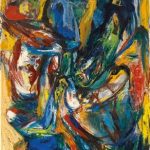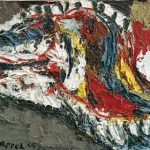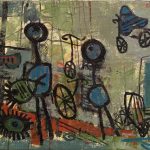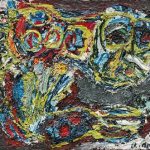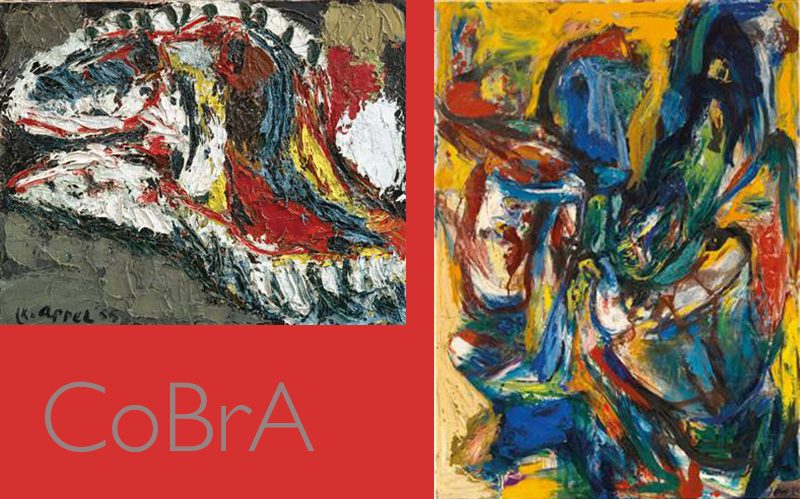
Their paintings are ruthless and aggressive, drawing upon the power of symbol and informal abstraction. The artists of the loose CoBrA group created a universe of fantastical images, both joyful and unsettling at the same time.
Overview of a movement
The CoBrA group has gone down in 20th-century art history as one of the first exponents of the European neo-avant-garde to emerge after the Second World War. Their roots lay in the Café Notre Dame in Paris: it was here that Belgian artists Joseph Noiret und Christian Dotremont, Dutch artists Karel Appel, Constant and Corneille, and the Danish artist Asger Jorn met and founded the CoBrA group in 1948. Its name – coined by Dotremont – is made up of the initials of the members’ home cities: Copenhagen, Brussels and Amsterdam.
Other painters – including Pierre Alechinsky, Robert Jacobsen, Pol Bury, Karl Otto Götz and Lucebert – subsequently joined the CoBrA movement, which was, however, to have only a brief existence as a group: it broke up in 1951. Nonetheless, the spirit of CoBrA survived, shaping both European and international art production.
Diversity and freedom beyond labels and definitions
CoBrA artists rejected any kind of labelling or definition of style. And yet the diversity and freedom of their oeuvre did not prevent their works – as was the case for most avant-garde artists – from speaking a characteristic language, and so a style did in fact emerge: the CoBrA style. Soon their work was admired by the public and praised by critics, thus putting an end to what had initially been a revolutionary project. Even after the group had dissolved, however, its former members remained true to the spirit and core principles of CoBrA in their later works.
What connected the various leaders of this movement were the open wounds that the Second World War had left. These fed their desire to overcome any kind of idealism, to make art an active force in social and political life. According to the convictions of CoBrA members, social roles had inhibited the individual’s natural urge to allow their creativity free rein. Hence the aim was to demystify the role of professional art and undermine the already well-defined art market of the time by advocating a folk art that could be created by everyone.
United by a purpose
CoBrA artists were driven by their intention to confront the academic world with a “return to origins,” an awareness of “raw,” pure, primitive art. They were poets of creative freedom, re-discoverers of the authentic spontaneity that Art Brut theoretician Jean Dubuffet (1947) had so glorified and admired, of a “naïve” art that was produced entirely through primal mechanisms – often with wonderful results; it played an essential role for the CoBrA movement and had a decisive influence on them.
Jorn, Appel, Constant, Corneille, Alechinsky and Lucebert created a universe of fantastical, powerfully symbolic images. They formed worlds inhabited by strange creatures both joyful and unsettling at the same time: cats, birds, primeval beings and distorted faces permeate and energise the CoBrA artists’ canvases. Their paintings are ruthless and aggressive, playing with bright colours and paste-like materials, drawing upon the power of the symbol and informal abstraction.
Anger as venom, art as antidote
The CoBrA movement can generally be assigned to Art Informel and specifically to gesturalism. This term is particularly apt for describing works that aim to express the artist’s creative rage. Brush and gesture merge, producing works that seem to have been flung onto the canvas quickly and effortlessly. “Beautiful, ugly, shocking, disgusting, meaningless, gloomy, contradictory … it doesn’t matter, so long as life surges out of it,” said Asger Jorn. Automatism as adopted by the Surrealists, Expressionism’s characteristic expression of inner emotions, the tendency towards childish, even grotesque imagination: these are the sources – together with obvious references to vivid Nordic folk art – that feed into the distinctive art of CoBrA.
„Let’s suppose that the first colour I apply to the canvas is red. Now that action determines everything else that happens to the painting. After that I could put yellow on it, and some blue. Then I might perhaps obliterate the red with black, and the blue would perhaps become yellow, and the yellow purple, while the black changes to white. Obviously anything can happen. But the whole fascinating process began with that first red, and if I hadn’t begun with red, the whole painting would have been different. Is there a system, is there order, in this chaos?“ (Karel Appel)
CoBrA strikes at Dorotheum
In November 2017, works by leading exponents of CoBrA will be up for auction at Dorotheum: “Earth Bird” (1955) by Karel Appel and “Brokigt brak – Patchy quarrel” (1964) by Asger Jorn, “Bicyclistes” (1948) by Corneille and “Rimes et raisons” (1989) by Alechinsky. With their broad, strong brushstrokes, shimmering colour contrasts and almost aggressive intensity, both evoke a dreamlike, even “childish” atmosphere. They are unmistakably part of the tradition of Nordic Expressionism shaped by the CoBrA artists.
AUCTION
Contemporary Art I
22 November 2017, 6 pm
Palais Dorotheum Vienna

